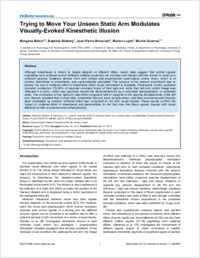Trying to move your unseen static arm modulates visually-evoked kinesthetic illusion
- Metral, Morgane Laboratory of Psychology and NeuroCognition, UMR 5105 CNRS – University of Savoie, Chambéry, France - Laboratory of Functional Neurosciences and Pathologies, EA 4559, Lille, France
- Blettery, Baptiste Department of Psychology, University of Savoie, Chambéry, France
- Bresciani, Jean-Pierre Department of Medicine, University of Friburg, Friburg, Switzerland
- Luyat, Marion Laboratory of Functional Neurosciences and Pathologies, EA 4559, Lille, France
- Guerraz, Michel Laboratory of Psychology and NeuroCognition, UMR 5105 CNRS – University of Savoie, Chambéry, France - Department of Psychology, University of Savoie, Chambéry, France
-
11.11.2013
Published in:
- PLoS ONE. - 2013, vol. 8, no. 11, p. e80360
English
Although kinesthesia is known to largely depend on afferent inflow, recent data suggest that central signals originating from volitional control (efferent outflow) could also be involved and interact with the former to build up a coherent percept. Evidence derives from both clinical and experimental observations where vision, which is of primary importance in kinesthesia, was systematically precluded. The purpose of the present experiment was to assess the role of volitional effort in kinesthesia when visual information is available. Participants (n=20) produced isometric contraction (10-20% of maximal voluntary force) of their right arm while their left arm, which image was reflected in a mirror, either was passively moved into flexion/extension by a motorized manipulandum, or remained static. The contraction of the right arm was either congruent with or opposite to the passive displacements of the left arm. Results revealed that in most trials, kinesthetic illusions were visually driven, and their occurrence and intensity were modulated by whether volitional effort was congruent or not with visual signals. These results confirm the impact of volitional effort in kinesthesia and demonstrate for the first time that these signals interact with visual afferents to offer a coherent and unified percept.
- Faculty
- Faculté des sciences et de médecine
- Department
- Département de Médecine
- Language
-
- English
- Classification
- Biological sciences
- License
-
License undefined
- Identifiers
-
- RERO DOC 209424
- DOI 10.1371/journal.pone.0080360
- Persistent URL
- https://folia.unifr.ch/unifr/documents/303610
Statistics
Document views: 219
File downloads:
- pdf: 225
